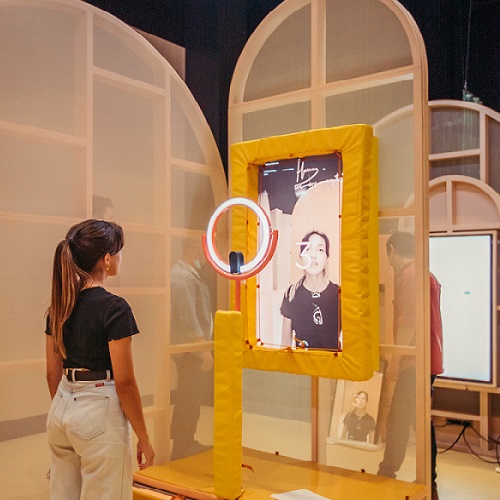08 February 2022
What do we miss when we’re not looking? Who are the people we don’t notice? What are the environmental changes we can’t see? Where does our data go when we switch off our phones?
The latest exhibition from MOD. at the University of South Australia pulls back the curtain on the parts of the world we don’t normally see, inviting visitors to explore what becomes visible when we start paying attention.
On now, INVISIBILITY features a number of interactive exhibits on topics ranging from climate change and lessons from Country, through to data privacy and Australia’s foster care system.
Director of MOD. Dr Kristin Alford says the exhibition is designed to spark conversations about four overarching questions – who is visible, what do we overlook, how do we perceive the invisible, and who controls what is visible?
“We took inspiration for INVISIBILITY from topics that were important to our audience – it turns out people have a lot to say when they pause to consider things they don’t normally see,” she says.
“Some people were really conscious about the digital footprints they leave behind. Some were concerned about invisible disabilities.
“Others were anxious about the once invisible changes of climate change that are now making themselves more seen.”
Dr Alford says climate change – a largely invisible global challenge where many of the effects won’t be witnessed until it’s too late – is a central theme across several exhibits.
“The interactive installation ‘Time Reveals the Unseen’ in the Museum’s main Universal gallery reveals the extent of human impact on the planet,” Dr Alford says.
“Visitors will be confronted with floor-to-ceiling images, developed by artist Yandell Walton, that expose environmental issues such as melting ice caps, coral bleaching, and ocean pollution.”
In the exhibit ‘Underground’, UniSA geoscientists Professor Tom Raimondo and Dr Alicia Pollett have collaborated with UniSA artists Peter Walker and Agnieszka Woznicka to take visitors on a journey underground.
Dr Alford says there is a lot to learn about the world around us from digging a little deeper.
“This exhibit explores UniSA research into the rocks located kilometres beneath the ground of the Nullarbor – which was once connected to Antarctica,” she says.
“The results can help us understand more about the land we live on and what the past can tell us about our future.
“While the latest climate change science shows that things are looking pretty dire, our exhibits also demonstrate that we each have a part to play.
“I hope visitors leave MOD. feeling inspired to consider the changes they can make before it’s too late.”
INVISIBILITY encompasses 13 exhibits spread across several gallery spaces. Other exhibits include:
 Show Your Stripes – We’re now looking down the barrel of a global increase in temperature of 1.5°C by 2030. The climate stairs located on North Terrace next to MOD. are a small part of a much larger international project from the Berkeley Earth data set, illustrating how the Earth has changed over time.
Show Your Stripes – We’re now looking down the barrel of a global increase in temperature of 1.5°C by 2030. The climate stairs located on North Terrace next to MOD. are a small part of a much larger international project from the Berkeley Earth data set, illustrating how the Earth has changed over time.
The Glass Room – A public intervention that aims to educate about technology. With a sleek tech shop vibe, visitors can freely and critically discuss their relationships with data privacy. Having toured Europe and the US, it will be visiting Australia for the first time in 2022.
Biometric Mirror – More 33,000 people looked at photographs of faces and judged them. They decided how calm or kind or weird they were. An algorithm was fed all this information, which it will now use to make judgements about you. The mirror is programmed to read your face to determine who you really are inside. But how accurate is it?
Ngapulara Ngarngarnyi Wirra (Our Family Tree) – Each AFL game, Adam Goodes’ body was tracked ten times per second by a global network of satellites. He now has access to billions of data points. For Adam, this data is culturally significant. This gallery reveals the kinship and culture hidden within the data.
Bokarra – In this interactive seasonal story, storyteller and artist Karl ‘Winda’ Telfer from the Mullawirra Meyunna (the Dry Forest People) will take you on a journey in preparation for the Kaurna Meyunna season of Bokarra, the hot and dry season between January and February.
INVISIBILITY runs from now to late November 2022 at MOD., located in the Bradley Building on North Terrace at UniSA’s City West campus. The Museum is open Tuesday to Saturday and entry is free.
For more information and a full list of exhibits, go to the MOD. website.
Background information
MOD. is a futuristic museum of discovery. It’s a place to be and be inspired by ideas at the intersection of science, art, and innovation.
The exhibition themes look at STEM broadly and the way that it can impact our lives, our societies, and our futures.
Media contact: Rosanna Galvin M: +61 434 603 457 E: rosanna.galvin@unisa.edu.au
Contact for interview: Dr Kristin Alford M: +61 410 442 629 E: kristin.alford@unisa.edu.au




